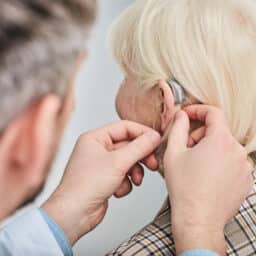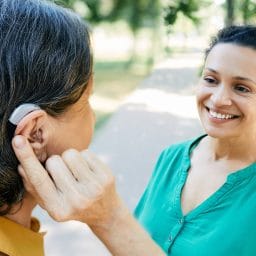How To Get Used to Your Hearing Aids

If you recently made the choice to get hearing aids to treat your hearing loss, congratulations! You’ve taken an essential step in prioritizing your hearing health. As you may have discovered, it can take a bit of time to get used to wearing hearing aids. To make things a little easier, consider the following tips….
University of Kentucky Audiologist Regarding High Volume Events at the concert or football stadium
University of Kentucky Audiologist Regarding High Volume Events at the concert or football stadium
How to Make the Most of Phone Calls When You Use Hearing Aids

Talking on the phone is one of the most notoriously difficult listening situations for people with hearing loss, in part due to the way many phones distort voices and also due to the fact visual cues are absent. However, there are many strategies for having successful telephone calls, especially if you wear hearing aids. Connect…
What Are the Differences Between Hearing Aids & Cochlear Implants?

Approximately 48 million Americans have hearing loss, and those who do have several options when it comes to treatment. Two types of hearing loss interventions that specifically address sensorineural hearing loss – or hearing loss caused by damage to sensory cells – are hearing aids and cochlear implants. There are some major differences between these…
Tips for Dining Out with Hearing Loss

Going out for a meal with family or friends somewhere like Palmers Fresh Grill is a great way to have fun and connect with others. However, if you have hearing loss, a busy restaurant environment can make it difficult to communicate. The good news is that there are steps you can take to help yourself…
4 Benefits of Treating Hearing Loss as a Senior

As you age, your risk of developing hearing loss rises. Approximately 1 in 3 people between the ages of 65 and 74 have some degree of hearing loss, and just under half of those who are older than 75 do as well. The good news is that by treating your hearing loss you’ll not only…
4 Ways Treating Hearing Loss Can Improve Your Relationships with Others

Hearing loss isn’t only difficult for the person affected with the condition. It can take a toll on their loved ones as well. Thankfully, treating your hearing loss can help keep your relationships healthy and strong. Hearing Aids Reduce Miscommunication Because hearing loss impacts your ability to process speech, it often leads to frequent miscommunication…
Four Ways to Feel Confident When Wearing Hearing Aids

Hearing aids can offer many benefits to those with hearing loss. However, it can take a bit of time to fully experience all that they have to offer. If you are new to hearing aids, let’s examine four ways you can increase your confidence when wearing your device. Fight Hearing Aid Stigma The first barrier…
9 Active Listening Techniques for People with Hearing Loss

Have you ever gone on a long walk at Broad Run Park and felt exhausted afterward? Have you felt the same sort of feeling after a lengthy conversation? If so, you’re familiar with a phenomenon known as listening fatigue. To combat listening fatigue related to hearing loss and be a better conversation partner, we recommend…
Power Ups: The Basics of Hearing Aid Batteries

Hearing aids consist of four main parts: a microphone, which picks up sounds in your environment; a processor, which amplifies sounds to a level the wearer can easily hear; a receiver, which delivers the amplified sounds to the ears; and a battery, which powers the device. Below we review everything you need to know about…